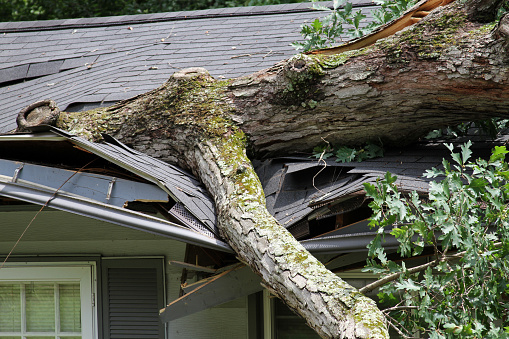The fall season always comes with reduced temperatures, crisp apples, and changing colors. Leaves change colors from regular green shades to yellows, oranges, or reds. Though the color change usually looks enchanting, these leaves pose damage when you leave them to fall on your roof. Such fallen leaves can retain water drops and cause other damage.
Here, you will learn about the possible damages of fallen leaves and how to prevent them from damaging your roofs.
Things You Can do to Prevent Fallen Leaves From Damaging Your Roofs
Since you know that fallen leaves aren’t things you should leave on your roof, how do you prevent the damage they cause? Below are some things you can do to prevent the damage fallen leaves cause on roofs.
· Trim your tree branches
You should first consider the source of the fallen leaves and the trees in your yard. Though big and tall trees provide enough shade for your home and its surrounding during the summer, they cause much mess in the fall.
Besides, having large trees around your roof poses other hazards that can damage your roof. It is, therefore, necessary for you to regularly trim the trees in your yard, especially the ones that surround your roof. This will help you reduce the number of fallen leaves you must remove from your roof.
That being said, you need to be careful when you want to trim down your trees. If the trees are very big and tall, consider hiring the help of professionals to trim them down.
· Clean leaves and other debris from your gutters
You must clean out dirt and debris from your gutters regularly. Keeping your gutter system free from dirt and debris ensures that it does what it needs: direct water away from your roof and the foundation of your home.
When you allow leaves to accumulate on your roof, they will eventually clog your gutter system. A clogged-up gutter system is easily susceptible to gutter overflow and basement flooding.
You must constantly clean your gutter to keep your roof free of fallen leaves. Another thing you should consider is installing a gutter cover to shield your gutters from leaves, twigs, and other debris.
· Perform regular roof inspections
It is necessary to must inspect your roof regularly. You must perform regular checkups to determine how many leaves have already built up on your roof. You can always perform an inspection looking from the ground up. Look out for fallen leaves, signs of water damage, discoloration, curling or missing shingles, mold growth, loose flashing, and anything out of the ordinary.
Do not attempt to climb the roof yourself. Hire roofing professionals like Roofpro to help you conduct a more thorough inspection. While you handle the ground-up visual inspection, you can have the professionals conduct the in-depth inspection at least twice or thrice a year.
Removing Fallen Leaves From Your Roof
Though you can take some measures to prevent fallen trees from piling up on your roof, it is impossible to stop every single one. As a result, you need to know how to remove the fallen trees on your roof before they build up.
Here are some tips for when you want to remove leaves from your roof:
- Only perform a ground-up inspection; don’t climb your roof if it has a sloped pitch.
- Use the right tools: An extendable rake or a blower can get the leaves off your roof.
- Allow wet leaves to dry up before you attempt to remove them from your roof.
Why You Should Remove Fallen Leaves From Your Roof
Even though it was built to be resilient, strong, and long-lasting, your roof is not immune to damage. If you don’t take care of your roof, it could last less time than it should.
Considering how extremely expensive it can be to get a new roof, it is a wiser investment to take good care of the one you currently have. A part of the care you should give to your roof involves clearing away fallen leaves from its surface. When you allow leaves to accumulate on your roof system, they are likely to soak up water and stick to your roof.
Wet leaves are bad for your roof, and when pressed against the roofing shingles, they can cause structural damage to your roof.
Wet leaves will make your shingles deteriorate quickly, and the fact that your shingles are your roof’s first line of protection makes this a serious issue. The shingles may crack, bend, or break off if you don’t detect them rotting. A shingle that is missing or fractured can allow water to enter. This can cause noticeable leaks and structural issues in your attic. The longer you expose your roofing system’s underlayment to runoff, the more damage it may sustain over time.
The Dangers Fallen Leaves Could Cause to Your Roof
You may regard fall leaves as just a mere nuisance to your roof and surroundings. However, if you allow them to pile up and decay on your roof, they can be agents capable of destroying your roof.
Below are some of the dangers fallen leaves may pose for your roof:
· An imbalanced roof surface:
The weight of wet leaves can cause an imbalance on your roof and then lead to damage. Wet leaves accumulating on your roof can become too heavy for your roof to handle. This exerts unnecessary pressure on your roof, which could cause damage over time.
· Trapped branches:
When leaves fall on your roof, they are likely to fall with short branches. Having too many branches along with leaves will eventually put much strain on your shingles.
Contact A Professional Roofing Contractor
Don’t wait until you notice problems with your roof before taking proper maintenance measures. Hire us at Roofpro, and let us help you with the necessary roof maintenance activities.
Call us at 250-248-3400 or reach out to us here.


